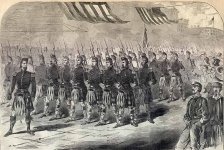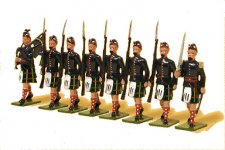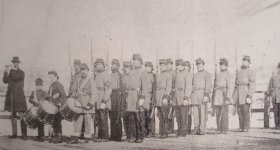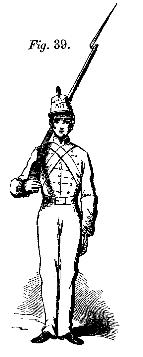A bit more on the Homer image of the 79th....
" Hey Scott! Good question. This comes up from time to time.... The Highland Guard / 79th New York used heavy infantry Tactics.
Quote:
While at the college we had been drilled frequently in the manual of arms by one or two West Point Cadets —or those just graduated from that institution. We followed Scott in this, and "carried" our muskets according to the heavy infantry practice ; when engaged in skirmish drill, however, Hardee's system was adopted. Both officers and men generally seemed anxious to become proficient in their military duties, although they never attempted any of the fancy movements practiced by some of the other regiments.
2nd Paragraph, Page 15 - The Seventy-ninth Highlanders, New York Volunteers in the War of Rebellion, 1861-1865
Here is an actual image of the 79th on parade:
Tyron Row, New York City - July 4th, 1860
The depiction and the image are the same. They are at Scott's Shoulder Arms as described below:
Quote:
150. Each recruit being in the position prescribed in the first lesson of the first part, the instructer will cause him to turn up the left hand without bending the wrist, the left fore-arm only acting. The instructer will raise the piece perpendicularly, and place it as follows :
151. (Plate III, fig. \ and 2.) The piece (fusil, musket, or firelock) in the left hand, the arm but a very little bent, the elbow back, near the body, the palm of the hand pressing on the outer flat of the butt; the outer edge of the latter on the upper joints of the fingers, the heel of the butt between the fore and middle fingers, the thumb on the front screw of the butt plate, the remaining fingers under the butt, the butt more or less kept back, according to the conformation of the recruit, so that the piece, seen from the front, shall appear perpendicular", and also that the movement of the thigh, in marching, may not raise it or cause it to waver ; the stock, below the tail-band, resting against the hollow of the shoulder, just within the joint, the right arm hanging naturally as prescribed in the first lesson of the first part.
Page 37 -Infantry Tactics: Schools of the soldier and company
Volume 1 of Infantry Tactics: Or, Rules for the Exercise and Manœuvres of the United States' Infantry, Winfield Scott
The manual says that the "piece ..shall appear perpendicular" But the slant is similar to that of "Right Shoulder- Shift"
http://www.southernguard.org/education/rss.html
Another fine example of how reality splits from regulations and manuals.
__________________
Rachel L. Kelly
79th New York Enthusiast
5th New York Co.D"






